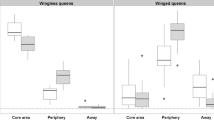Abstract
Although related, Cataglyphis floricola and Cataglyphis tartessica show very different responses to colony orphaning. In the laboratory, under queenless conditions, C. tartessica workers produced male offspring via arrhenotoky, while C. floricola workers produced female offspring, including new queens, via thelytoky. Both species have workers with active ovaries that produce trophic eggs. In the field, in the late spring, C. floricola colonies were more likely to be orphaned than were C. tartessica colonies, probably due to differences in how they performed fission, their colony foundation system. The combined action of these two features could explain the presence of thelytoky in C. floricola and its absence in C. tartessica.


Similar content being viewed by others
References
Agoze M, Drezen JM, Renault S, Periquet G (1994) Analysis of the reproductive potential of diploid males in the wasp Diadromus pulchellus (Hymenoptera: Ichneumonidae). Bull Ent Res 84:213–218
Amor F, Ortega P (2014) Cataglyphis tartessica sp.n., a new ant species (Hymenoptera: Formicidae) in south-western Spain. Myrmecol News 19:125–132
Amor F, Ortega P, Cerdá X, Boulay RR (2011a) Solar elevation triggers foraging activity in a thermophilic ant. Ethology 117:1031–1039
Amor F, Ortega P, Jowers MJ, Cerdá X, Billen J, Lenoir A, Boulay RR (2011b) The evolution of worker-queen polymorphism in Cataglyphis ants: interplay between individual and colony-level selections. Behav Ecol Sociobiol 65:1473–1482
Boulay R, Aron S, Cerdá X, Doums C, Hefetz A, Monnin T (2017) Social life in arid environments: the case study of Cataglyphis ants. Ann Rev Entomol 62:305–321
Bourke AFG (1988) Worker reproduction in the higher eusocial Hymenoptera. Q Rev Biol 63:291–311
Cagniant H (1979) La parthénogénese thélytoque et arrhénotoque chez la fourmi Cataglyphis cursor Fonsc. (Hym. Form.). Cycle biologique en élevage des colonies avec reine et des colonies sans reine. Insect Soc 26:51–60
Cowan DP, Stahlhut JK (2004) Functionally reproductive diploid and haploid males in an inbreeding hymenopteran with complementary sex determination. Proc Natl Acad Sci USA 101:10374–10379
Cronin AL, Chifflet-Belle P, Fédéreci P, Doums C (2016) High inter-colonial variation in worker nestmate relatedness and diverse social structure in a desert ant from Mongolia. Insect Soc 63:87–98
Crozier RH, Pamilo P (1996) Evolution of social insect colonies: sex allocation and kin selection. Oxford University Press, Oxford
Doums C, Cronin AL, Ruel C, Fédérici P, Haussy C, Tirard C, Monnin T (2013a) Facultative use of thelytokous parthenogenesis for queen production in the polyandrous ant Cataglyphis cursor. J Evol Biol 26:1431–1444
Doums C, Ruel C, Clémencet J, Fédérici P, Cournault L, Aron S (2013b) Fertile diploid males in the ant Cataglyphis cursor: a potential cost of thelytoky. Behav Ecol Sociobiol 67:1983–1993
Eyer PA, Leniaud L, Darras H, Aron S (2013) Hybridogenesis through thelytokous parthenogenesis in two Cataglyphis desert ants. Mol Ecol 22:947–955
Gobin B, Peeters C, Billen J (1998) Production of trophic eggs by virgin workers in the ponerine ant Gnamptogenys menadensis. Physiol Entomol 23:329–336
Greeff JM (1996) Effects of Thelytokous Worker Reproduction on Kin-Selection and Conflict in the Cape Honeybee, Apis mellifera capensis. Philisoph Trans R Soc B 351:134
Hammond RL, Keller L (2004) Conflict over male parentage in social insects. PLoS Biol 2:e248
Hölldobler B, Wilson EO (1990) The ants. Harvard University Press, Berlin
Jowers MJ, Amor F, Ortega P, Lenoir A, Boulay R, Cerdá X, Galarza JA (2014) Recent speciation and secondary contact in endemic ants. Mol Ecol 23:2529–2542
Leniaud L, Darras H, Boulay R (2012) Social hybridogenesis in the clonal ant Cataglyphis hispanica. Curr Biol 22:1188–1193
Leniaud L, Hefetz A, Grumiau L, Aron S (2011) Multiple mating and supercoloniality in Cataglyphis desert ant. Biol J Linn Soc 104:866–876
Miyakawa MO, Mikheyev AS (2015a) Males are here to stay: fertilization enhances viable egg production by clonal queens of the little fire ant (Wasmannia auropunctata). Sci Nat 102:15
Miyakawa MO, Mikheyev AS (2015b) QTL mapping of sex determination loci supports an ancient pathway in ants and honey bees. PLoS Genet 11(11):e1005656
Pearcy M, Aron S, Doums C, Keller L (2004) Conditional use of sex and parthenogenesis for worker and queen production in ants. Science 306:1780–1783
Pearcy M, Goodisman MAD, Keller L (2011) Sib mating without inbreeding in the longhorn crazy ant. Proc R Soc Lond Ser B 278:2677–2681
Pearcy M, Timmermans I, Allard D, Aron S (2009) Multiple mating in the ant Cataglyphis cursor: testing sperm limitation and the diploid male load hypotheses. Insect Soc 56:94–102
R Core Team (2012) R: a language and environment for statistical computing. R Foundation for Statistical Computing, Vienna
Rabeling C, Kronauer JC (2013) Thelytokous parthenogenesis in eusocial Hymenoptera. Annu Rev Entomol 58:273–292
Rispe C, Pierre JS, Simon JC, Gouyon PH (1998) Models of sexual and asexual coexistence in aphids based on constraints. J Evol Biol 11:685–701
Smith JM (1971) What use is sex? J Theor Biol 30:319–335
Teseo S, Kronauer DJC, Jaisson P, Châline N (2013) Enforcement of reproductive synchrony via policing in a clonal ant. Curr Biol 23:328–332
Timmermans I, Hefetz A, Fournier D, Aron S (2008) Population genetic structure, worker reproduction and thelytokous parthenogenesis in the desert ant Cataglyphis sabulosa. Heredity 101:490–498
Tsuji K (1995) Reproductive conflicts and levels of selection in the ant Pristomyrmex pungens: Contextual analysis and partitioning of covariance. Am Nat 146:586–607
West-Eberhard MJ (1981) Intragroup selection and the evolution of insect societies. In: Natural selection and social behavior. Alexander RD, Twinckle DW (eds), Chiron, New York, pp. 3–17
van Wilgenburg E, Driessen G, Beukeboom LW (2006) Single locus complementary sex determination in Hymenoptera: an “unintelligent” design? Front Zool 3:1
Acknowledgements
We thank Sara Castro and Benjamin Carbonne for their help in the field. Fieldwork facilities were provided by ICTS-RBD. Ant collection procedures and experiments comply with Spanish legislation. This study was funded by the Spanish Ministry of Economy and Competitiveness and FEDER (projects CGL2012-36181 and CGL2015-65807).
Author information
Authors and Affiliations
Corresponding author
Electronic supplementary material
Below is the link to the electronic supplementary material.
Rights and permissions
About this article
Cite this article
Amor, F., Ortega, P., Boulay, R. et al. Frequent colony orphaning triggers the production of replacement queens via worker thelytoky in a desert-dwelling ant. Insect. Soc. 64, 373–378 (2017). https://doi.org/10.1007/s00040-017-0556-9
Received:
Revised:
Accepted:
Published:
Issue Date:
DOI: https://doi.org/10.1007/s00040-017-0556-9




